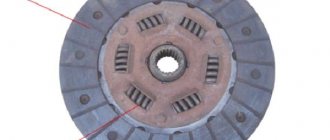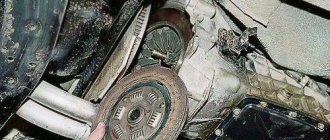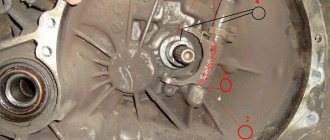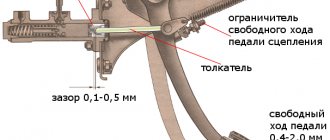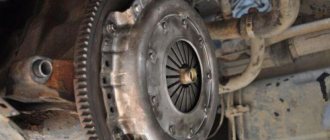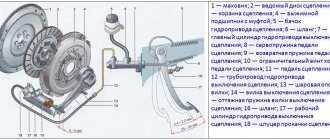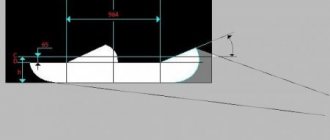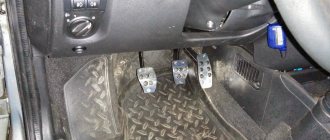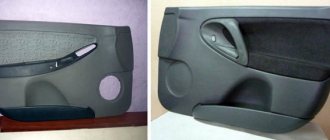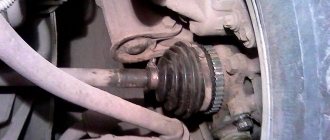Popular domestic model
Lada Kalina is very popular among Russian car enthusiasts, but most of its owners note that the model has a number of significant shortcomings. In particular, criticism is caused by the appearance, comfort and technical equipment of the machine.
Many claims have been made regarding how the Lada Kalina clutch works
. Although, reading the instructions for this vehicle, it is difficult to believe that any malfunctions could occur when the clutch operates.
How to tighten the clutch cable on a viburnum
The popular domestic model
Lada Kalina is very popular among Russian car enthusiasts, but most of its owners note that the model has a number of significant shortcomings. In particular, criticism is caused by the appearance, comfort and technical equipment of the machine.
Many claims have been made regarding how the Lada Kalina clutch works . Although, reading the instructions for this vehicle, it is difficult to believe that any malfunctions could occur when the clutch operates.
Additional Information on Clutch Cable Compensating Mechanism
The compensation mechanism on the Lada Kalina clutch cable is designed to ensure that the clutch cable is always in a tense state. A slight deviation of 1-2 mm is either “selected” or added to the length by the compensating mechanism.
Undoubtedly, the Lada Kalina is a fairly popular car among domestic car enthusiasts. Moreover, the fact that it has quite a large number of flaws and shortcomings does not at all affect the high popularity of this particular model from the Lada family. The clutch on the viburnum has always been problematic.
If you look at the design of the clutch itself, it’s hard to believe that the Lada has problems there and requires fairly frequent adjustment of the clutch on the viburnum.
Clutch device
The clutch of this model from AvtoVAZ is single-disk and belongs to the dry subtype. It is equipped with a pressure spring located in the center. The pedal is connected to the clutch disc using a special cable, the length of which is adjusted by a ratchet mechanism. This can be seen if you watch a video demonstrating the design of Kalina.
The lining of the dependent disc wears off and becomes thinner during use. The malfunction is eliminated using a ratcheting mechanism, which compensates for wear by tensioning the cable. The tension causes the release fork to rotate and compress the spring, which is located in the bushing of the control mechanism. The spring, in turn, compresses the clamps located on the toothed tip of the cable. As a result of all these manipulations, the tip is released and the cable is tensioned.
The ratcheting mechanism eliminates the need for car owners to waste time and effort on adjustments. But this is only in the theory developed by Kalina's designers. In reality, when operating a car, you need to know how to adjust the clutch yourself.
When adjustment is required
Clutch adjustment is only performed when the engine is switched off. It is required if there is a deviation from the following values:
- full pedal travel does not exceed 146 mm;
- movement of the cable lead relative to the release fork lever - within 270 mm;
- runout of the dependent disc linings does not exceed 0.5 mm;
- the distance between the pads and the rivets that hold them is 0.2 mm or less.
There are several ways to check if your car needs a clutch adjustment.
- You should press the pedal several times in a row and listen for any extraneous noise. If the clutch pedal sticks or squeaks, it is advisable to make an adjustment. In some cases, car owners are unable to visually assess whether the pedal returns to its place freely. In such situations, it is recommended to do the following:
- press the clutch with your hand until it stops;
- stop applying force, but leave your hand on the pedal in order to feel if there is movement.
If the clutch pedal sticks and clicks, or it returns to its original position with characteristic jerking, you need to adjust the clutch.
It is necessary to measure the distance from the floor to the outer part of the pedal using a ruler or caliper. Then press the pedal until it hits the floor. After this, you need to release the pedal and take measurements again. If the distance exceeds 146mm, be sure to adjust the clutch.
Operations for adjusting the clutch cable Lada Kalina
1. Set the clutch cable to its original position; to do this, overcoming the force of the spring of the mechanism, move the lower tip of the cable all the way forward, that is, in the direction of movement of the car. Hold the tip in an extended position, measure the size (see photo for size L) between the fork and the leader, it should be 27 mm. If the size does not correspond to the required value, then adjust it by rotating the leash in the desired direction.
2. Insert the end of the cable into the groove of the clutch release fork and release. Under the action of the spring, the tip driver should be installed on the fork without any gap. 3. Press the clutch pedal several times until it stops and again measure the previously controlled distance (look at the photo for size L). If necessary, repeat the adjustment until you reach the desired value of 27 mm.
The procedure for adjusting the clutch on Kalina
Owners of Lada cars who have discovered faults in their vehicles are interested in how to adjust the clutch. To do this you need to perform a number of steps.
- Pull the cable forward until it stops at the threaded end. In this case, it is necessary to overcome the resistance of the spring attached to the clutch pedal.
- While holding the cable, use a caliper to measure the distance from the plastic leash to the clutch release fork lever.
- By rotating the leash, bring the distance to the required values. Make sure that when releasing the cable, the leash fits tightly to the fork lever.
- Press the clutch pedal three times to activate the automatic cable length adjustment system.
- Check the full pedal travel.
Adjusting the clutch on a Kalina car is a procedure that every owner of this car must master. By performing timely adjustments, you can significantly extend the life of your vehicle.
Like all “basins”, Kalina is not at all flawless. Over its more than ten-year history, the model has been refined more than once, but it has not been possible to get rid of some problems. Among the “Kalinovodov” it is recognized that the torque transmission mechanism, due to its design features, is the weak link of the car. Despite all the modernization in this area, car enthusiasts have to periodically adjust the clutch.
Replacing the clutch cable
In the cabin under the instrument panel..
. Using an “8” wrench, unscrew the nut securing the cable sheath bracket to the pedal assembly bracket.
Use a slotted screwdriver to pry up the spring clip. . and remove it from the groove of the clutch pedal finger.
Remove the eye of the housing of the automatic cable length adjustment mechanism from the clutch pedal pin.
We remove the upper part of the cable from the pedal assembly bracket. In the engine compartment.
. Pull the cable forward and remove the cable guide from the groove of the clutch release fork lever.
Rotating counterclockwise, unscrew the leash from the threaded end of the cable.
Remove the rubber protective cover from the cable end.
We remove the end of the cable sheath from the hole in the bracket on the gearbox. In the cabin, remove the cable sealing cover from the hole in the front panel.
. and pull the cable into the cabin. Before installing the cable...
. check the condition of the plastic bushing on the pedal pin. We replace the worn bushing with a new one and apply grease to the pin. We install the cable in the following sequence: - thread the cable through the hole in the front panel from the passenger compartment into the engine compartment; — install the sealing cover into the hole in the front panel; — put the automatic cable length adjustment mechanism on the pedal pin and fasten it; — screw a plastic leash onto the threaded end of the cable so that the end of the cable tip is flush with the end of the leash; — insert the leash into the groove of the clutch release fork lever; — adjusting the clutch drive To do this, pull the cable forward by the threaded end until it stops, overcoming the force of the clutch pedal spring, and hold the cable in this position.
Using a caliper, we measure the distance from the end of the plastic leash to the clutch release fork lever, which should be 27 mm. If necessary, rotate the leash to achieve the required distance. When removing the load (releasing the cable), the leash should adhere to the fork lever without play. After this, press the clutch pedal three times to activate the automatic cable length adjustment mechanism. The full pedal travel should not exceed 146 mm.
Features of the VAZ 2112 clutch
The machine is equipped with a dry-type single-plate friction clutch with a central pressure spring. adjusting the clutch on Kalina any motorist must take into account that the control pedal is connected to the disc via a cable with a special ratcheting mechanism.
How does automatic cable tightening work?
As a result of intensive use, the friction linings of the disc gradually wear out. The ratcheting mechanism built into the drive design allows you to compensate for wear for a certain period of time - it gradually tightens the cable. During operation of the device, the fork rotates and the bushing spring is gradually compressed. As a result, the cable end clamps are compressed, after which the latter is released and tensions the cable.
The purpose of this design is to facilitate the maintenance process. According to the plans of VAZ engineers, the mechanism should save the owner from the need to make adjustments himself. But this is all only in theory, but in practice it turns out that you cannot do without adjusting the clutch.
When should adjustments be made?
Before adjusting the clutch on a Kalina car, you need to determine the moment when the automatic cable locking no longer functions. This is not difficult, especially since the machine itself signals problems:
- Loss of traction, friction clutch does not provide a reliable connection between the flywheel and the disk. The consequence of such a defect will be the loss of a significant part of the torque force.
- The clutch control pedal does not return to its initial position, which, in fact, is a consequence of the first point.
- Poor clutch disengagement - the pedal is not pressed all the way, which makes changing gears difficult.
The symptoms, however, are similar to those when clutch adjustment is needed on a VAZ 2107 , so experienced motorists can skip this unit and proceed directly to the test.
How to check the clutch?
To make sure that the mechanism needs to be adjusted, you should perform a number of basic checks:
- Press the pedal several times and release - any extraneous sounds are unacceptable. For better control, you can press with your hand, this way you can feel the pedal stroke more fully.
- Check the pedal for sticking; if it returns with noticeable twitching, then adjustment is necessary.
- Check the full travel of the pedal using a ruler or tape measure. Press and release the pedal several times, then measure the distance of its outer edge to the floor; if it is more than 146 mm, then the mechanism needs to be adjusted.
- Check the movement of the cable guide relative to the clutch release fork; the maximum distance between these elements is 27 mm.
- If the runout of the driven disk linings is more than 0.5 mm, adjustment is also required.
Diagnosis of clutch faults
Lada Kalina is equipped with a “dry” clutch with one disc and a central pressure spring. The disc is connected to the clutch pedal (CP) using a cable. The interaction is carried out using a cable, which is the weak point in the node. Adjustment is carried out using a ratchet mechanism, which is a rod with a thread and a control nut.
Clutch diagram for Lada Kalina
Over time, the linings on the disc wear out and become thinner. Wear largely depends on the driver's driving style. For those who like to tear it apart, the unit will not last long and will need to be repaired. Using a ratchet mechanism, insufficient thickness of the lining is eliminated by tightening the cable. This happens by turning the release fork, it forces the spring located in the bushing to compress. The spring acts on the tip clamps, releases it and, thus, tensions the cable.
Correct adjustment of cable length
Thanks to the ratchet mechanism, the length of the cable is automatically adjusted. But despite this, sometimes you have to adjust it manually.
There are obvious signs by which you can diagnose whether the clutch assembly needs to be adjusted, namely:
- problems when shifting gears;
- extraneous sounds when squeezing the PS: creaking, friction, clicks;
- the clutch does not disengage/engage completely;
- poor traction;
- jamming when moving the PS.
The video by Sergei Tsapyuk explains the reason for the pedal being too tight and how to fix the problem.
Using simple steps, you can identify other signs indicating that the clutch on the Lada Kalina needs to be adjusted:
- start the engine;
- press the PS several times, listening to the sounds, whether there are any creaks or clicks;
- press the pedal to the floor, release it and measure the distance from the floor to the pedal - full stroke PS: it should not exceed 14.6 cm, if you need to tighten the cable more;
Measuring the distance between the floor and the pedal
- the free play of the PS should be 2.5 - 3 cm;
- the runout of the linings on the driven disk should not be more than 0.5 mm, and the gap between the linings and the rivets holding them should not be more than 0.2 mm.
If the above symptoms are detected, then it is necessary to either adjust the clutch or replace it.
Without noise and dust: how to properly adjust the clutch on a Kalina station wagon yourself?
You should start working no earlier than the engine has completely cooled down. The setup method is simple and does not require a visit to a car service center, because you can do everything yourself. The step-by-step scheme for completing the work is as follows:
- Before adjusting the clutch drive on Kalina, you should open the engine compartment hood and remove the air filter.
- Visually assess the condition of the cable casing and replace it if damaged.
- Pull the tip toward you until the cable is fully tensioned. After this, check the distance between the fork and the leash with a caliper.
- If the measurements show more than 27 mm, then the distance is corrected by rotating the leader along the thread of the tip.
- Press and release the clutch pedal several times and repeat the measurements.
- If necessary, repeat the adjustment until the required standards are achieved.
The technology for setting up the clutch on Kalina is not as complicated as installing the VAZ 2110 clutch , therefore it is quite feasible in a garage environment without the involvement of specialists. And this fact pleases domestic motorists, because the clutch plays an important role in driving a car.
To be more precise, we will talk about adjusting the clutch cable on the Lada Kalina. The Kalinovsky cable is much easier to adjust than the same cable on the 9, 10, 15. All because of the installed auto-compensator, which does this work for you. So if the autocompensator does everything itself, then why bother with it at all? Let's figure it out.
The fact is that for the correct operation of this machine, the clutch cable must be installed correctly. Correct installation is determined by measuring and adjusting several distances. The first is between the clutch fork and the plastic cable end. We pull the cable to the maximum possible distance, holding on to this plastic tip and using a caliper we measure the gap - it should be 27 mm (as in the book). To get to the fork you need to remove the air filter. If the distance is not the same, we adjust it to the norm using the same plastic tip.
The second thing you need to pay attention to is the cable rod on the interior side. The distance of its end to the plate should not exceed 3 mm, but at the same time some gap should remain. It is located on the clutch pedal itself.
You can set the gaps either from the hood or from the interior, where it is more convenient for you. Having set one gap, the second should happen automatically.
Clutch pedal on grant creaking, clicking, adjustment
About the clutch pedal on the Lada Granta
Such a unit on any car is a transmission element, with the help of which, when the pedal is pressed, the transmission of torque from the engine to the gearbox, and then to the drive wheels, is interrupted. With its help, it is possible to smoothly start from a place after parking the car, or change gears while driving. On the Lada Granta, the clutch is installed from its predecessor, the Lada Kalina.
This transmission unit has a traditional, backlash-free classical design. This indicates that there is no play between the pressure spring and the bearing that releases the clutch. It is driven by pressing the pedal using a cable. This unit consists of a flywheel on which the basket is attached. It provides constant pressure on the pressure plate to transmit torque from the engine. This unit, like all mechanisms, sometimes requires adjustments and repairs. Let's talk about how the adjustment is performed in more detail.
Adjustment work
On this car, the drive is carried out using a cable that has an automatic tension system, or, as it is also called, a wear compensator. If everything is done and the adjustment is carried out correctly, then the owner of the car during operation does not need to adjust the gaps or make adjustments to the release pedal.
Be that as it may, problems still happen sometimes. A variety of reasons contribute to this. Various noises may appear during operation, the clutch clicks, the pedal creaks. There may be other unusual manifestations while driving the Lada Granta.
The correct gap is considered to be the case when its value between the power fork and the wing is 27 millimeters.
This is followed by mandatory lubrication of all elements in the pedal assembly. At the same time, we must not forget about the plastic of the compensator ratchet, clutch bushing, and the casing of its drive cable.
When this adjustment is made, there is usually no more clicking in the drive, and the pedal does not make unpleasant sounds.
Sometimes a squeaking sound can come from the engine compartment of a car. Its source may be the tip lead. To eliminate this squeak, it is enough to lubricate the contact point between the plastic nut and the clutch release fork.
In some cases, the cause of squeaks from the engine compartment may be a lack of lubrication on the gearbox input shaft. In such cases, graphite lubricant in a can comes to the rescue. To eliminate this malfunction, remove the engine protection and lubricate the rubbing parts.
When the source of extraneous noise is the clutch release cable, you should also try to lubricate it with graphite lubricant. Insert the canister tube between the cable and the casing and try to lubricate it. In cases where this does not help, change the drive cable.
If, after all the adjustment work, you still hear extraneous sounds from the clutch side, something clicks there and the pedal creaks. Then you need to contact a car service for a more complete check of this unit.
Clutch replacement work
Check the wear of the friction linings of the pressure plate. If wear exceeds the permissible limit, it is replaced with a new one.
Installation on the flywheel is carried out in the reverse order.
What does incorrect adjustment of the Kalina clutch lead to?
If the gaps are not set correctly, the auto compensator may not work correctly, or may not work at all if the gap under the hood is too low (10mm or less). The release bearing may also howl.
For example, my release bearing was humming in 4th and 5th gears. After adjusting the clutch cable , the noise disappeared. Many questions also arise about the fact that the clutch “takes over” at the very end. This is, in principle, normal. Structurally, the clutch on Kalina begins to grab in the second half of the stroke. Therefore, setting it up to start the stroke means making constructive changes to its operation, which is not desirable.
Source
Viburnum clutch cable stretched
- To the beginning of the forum
- Forum Rules
- Old design
- FAQ
- Search
- Users
the skiff comes to the clutch.
It is unlikely. Although it may be. God forbid I (Allah, Krishna Buddha - underline what is necessary, add what is missing) to give advice, but it looks like the oil in the gearbox needs to be changed.
When I press the pedal, I hear some kind of creaking sound, like “kr-prrr-trrr”, I quote verbatim, maybe the cable is loose. Moreover, the sound is heard precisely when the pedal is moved, and sometimes it is not there at all.
“kr-prpr-trrr”, I quote verbatim, maybe a skiff cable.
I got rid of the “cr-prpr-trrr” by pumping engine oil under the cable braid with a syringe
“kr-prpr-trrr”, I quote verbatim, maybe a skiff cable.
I got rid of the “cr-prpr-trrr” by pumping engine oil under the cable braid with a syringe
forced lifting of the pedal - khan fork hum at XX - khan release clutch is tight, then suddenly soft, as well as pedal trembling - khan basket
Now the question of the day: There are both bourgeois (KRAFT, VALEO) and our shitty clutch assemblies on sale (VIS). So on all the bourgeois ones they write that it is suitable for 2110 and 2112. VIS has different baskets for 2110 and 2112. The question is WHAT? (yesterday at the service they put a cart for me on 2110 for 2112 - as a result - complete crap, I'll go again tomorrow
)
the pedal has become soft, the force appears at the very end of the pedal stroke.
This is how my basket died, slowly getting hot after an hour of driving, then earlier and earlier
Source
Peculiarities
The cable installed in the VAZ model under consideration has a special ratcheting mechanism. It allows you to adjust the length of the pull. At the same time, the clutch in any car is used quite actively, which is why the friction linings of its discs wear out. As a result, the cable tension decreases.
The ratchet mechanism, in theory, provides protection against loosening. The trouble is that in practice this does not work very well, and periodically the traction element still has to be adjusted manually.
Troubleshooting Sensor Problems
This mechanism is installed only on the Lada Kalina clutch with an electronic gas pedal. Its function is to control engine modes when changing gears, starting to drive, etc. Sensor malfunctions are reflected on the engine controller as “error 0830”, and the Check Engine lamp lights up. Physically, malfunctions are felt as jerking of the car when changing gears, when the engine is running at low speeds, or a sudden increase or decrease in engine speed when you press the pedal. It is impossible to adjust the clutch sensor on Kalina; it will have to be completely replaced.
This part is located above the pedal, under the steering column. When buying a new one, you should choose sensor 1118-3720015 (for Kalina, Priora, Grants). Replacing it is a little complicated by the inaccessibility of the 2 screws on which it is attached to the pedal bracket.
To remove the sensor, you need to pull the wire block holder out of the hole on the pedal bracket. Then disconnect it from the dashboard wiring harness. Use a screwdriver to remove the spring hook from the holder and unscrew the sensor mount on the pedal bracket (screws).
How to properly adjust the clutch in a car?
After repairing or replacing the clutch, and sometimes when using the car, the gears stop shifting clearly and smoothly, the car jerks, and slips when starting off. This happens due to an unadjusted clutch, and we will talk about this in our article.
You can adjust the clutch yourself
The main signs by which you can understand that it is time to adjust the clutch
The approximate mileage interval at which it is recommended to check and adjust the clutch operation is 10,000 kilometers. It is worth checking the car maintenance schedule established by the manufacturer - other numbers may be indicated here.
Clutch adjustment is required after replacing/repairing the clutch or its elements, for example, the drive cable. The procedure is required even if there is a suspicion of deviation of the pedal amplitude from normal values:
- the car starts moving jerkily;
- the clutch pedal sinks or moves with difficulty;
- the fluid level in the hydraulic drive decreases;
- When changing gears you notice shock, noise and vibration.
A simple test will help you determine if the clutch needs adjustment. We start the engine, smoothly release the clutch pedal and slowly move away. If the car remains in place when the clutch is fully released, then the pedal travel has increased. If the car starts moving before you even take your foot off the pedal, its travel is too slow.
What happens if you don't adjust the clutch in time?
A clutch that is not adjusted in time will quickly fail, so it will soon have to be repaired or completely replaced. With increased pedal travel, the clutch is not completely disengaged; its disk is constantly pressed against the engine flywheel. With a small stroke, the clutch is not able to fully engage the driven disc, which leads to slipping and lack of torque.
Driving a car with an unadjusted or faulty clutch is dangerous and can lead to an accident!
Lack of adjustment is the reason for rapid clutch failure
Can I adjust the clutch myself?
You can adjust the clutch without going to a technical center. But if you are not sure of the causes of the problem, you do not have the necessary tools and have never encountered car repairs before, entrust the work to professionals.
To adjust the clutch you will need a ruler, liquid lubricant, pliers and open-end wrenches of two sizes - 17x14 and 13x14.
Clutch adjustment steps
Most often, modern cars have two types of clutches:
- with a mechanical drive
- the clutch fork is connected to the pedal in the cabin using a cable; - with a hydraulic type drive
- the gas pedal is connected to the clutch slave cylinder by a pipeline filled with working fluid.
The adjustment procedure depends on the type of unit.
Adjusting the mechanical clutch
First, let’s find out whether the pedal stroke decreases or increases. We press the pedal all the way and measure how far from the floor it stops. Let's release the pedal and take measurements again. From the second indicator we subtract the first. For most models, the normal stroke amplitude is in the range of 12 - 14 cm, this can be clarified in technical documents. If the number is less, the pedal stroke needs to be increased, if it is more, it should be decreased.
After the measurements, we move on to the adjustment procedure itself:
Stage 1
– open the hood, find a rod near the transmission lever that secures the cable coming from the clutch pedal.
Stage 2
– lubricate and loosen the nuts that secure the rod with liquid lubricant.
Stage 3
– using wrenches, turn the nut that was closer to the pedal. If you turn the nut towards the clutch pedal, the free play of the pedal will become greater, if in the opposite direction - less.
Stage 4
– again measure the amplitude of the pedal stroke. If it is within the normal range, tighten the second nut – the control one – until it stops. This is necessary to record the adjustments made. If the stroke is still too large or small, tighten the nut that is closer to the pedal.
Reasons for failure
The first factor that accelerates wear of the clutch in general and the cable in particular is the high intensity of operation of the machine. If you drive it every day, then rest assured that our imperfect roads and difficult weather conditions will do everything possible to ensure that the car’s parts become unusable before the deadline.
The cable also breaks faster for drivers who are accustomed to driving aggressively - taking off sharply, braking at full speed, etc. Moreover, even Kalina, who rarely leaves the garage, is not protected from the trouble in question. Over time, the adjustment is disrupted and the traction is gradually weakened. Sometimes it just sours in the shell and stops moving.
When adjustment is required
Clutch adjustment is only performed when the engine is switched off. It is required if there is a deviation from the following values:
- full pedal travel does not exceed 146 mm;
- movement of the cable lead relative to the release fork lever - within 270 mm;
- runout of the dependent disc linings does not exceed 0.5 mm;
- the distance between the pads and the rivets that hold them is 0.2 mm or less.
There are several ways to check if your car needs a clutch adjustment.
- You should press the pedal several times in a row and listen for any extraneous noise. If the clutch pedal sticks or squeaks, it is advisable to make an adjustment. In some cases, car owners are unable to visually assess whether the pedal returns to its place freely. In such situations, it is recommended to do the following:
- press the clutch with your hand until it stops;
- stop applying force, but leave your hand on the pedal in order to feel if there is movement.
Why adjustment is necessary
The free play of the clutch cable increases as the clutch parts wear.
During the operation of Kalina, the clutch assembly may require adjustment.
This happens both due to design features and in the process of natural abrasion of the driven disk linings . Therefore, the clutch cable must be adjusted periodically.
Adjustment process
The adjustment process is simple and is performed in several stages:
- To get to the adjustment mechanism, you need to remove the air filter housing .
The diagram shows the mounting locations of the air filter housing.
Clutch adjustment mechanism - view with the air filter removed.
We measure the size, holding the tip in an extended position.
The correct distance is 27 mm.
After adjustment, you may notice slight squeaks coming from the clutch assembly. Most often, sounds arise as a result of friction of parts. They can be eliminated by applying lubricant to the place where the fork contacts the cable end nut.
Source
When is replacement needed?
Of course, the cable will have to be changed in any case when it breaks. But it’s better not to let things get to this point - think about repairs when you notice that the tip has begun to become shaggy. Even a couple of broken wires seriously reduces the strength of the element. You should also consider replacement if the plastic shell wears down significantly.
It should be understood that the clutch cable installed in the Lada Kalina gradually stretches, even if the owner of the car drives it very carefully. Eventually it will become so loose that the driver will one day simply not be able to change gear.
The following signs indicate that there is something wrong with the cable:
- when the clutch is activated, uncharacteristic sounds are heard;
- gears are difficult to shift;
- the pedal fails;
- the clutch does not disengage completely;
- craving weakens.
If you have at least one of the above symptoms, you should think about a technical inspection and then, depending on the circumstances, replacement or adjustment.
Changing the clutch cable on Lada Kalina
Failure of the clutch cable on Kalina causes serious problems in the functioning of the gearbox.
When you try to shift, the clutch pedal falls down, a grinding noise occurs, and changing into gear is impossible. This indicates that the cable has either stretched or broken.
And in this case, it needs to be replaced.
Cable replacement process
The work schedule includes the following actions:
- We begin work from the salon. Find the clutch drive pedal.
- Remove the stop from the cable sheath. To do this, unscrew the nut through which the shell is attached to the bracket. After this, the stop is simply removed from the stud .
Remove the clamp from the clutch pedal axis.
Remove the tip from the clutch pedal.
We prepare the workplace - remove the air filter housing (for complete convenience, you can also remove the battery)
Unscrew the plastic tip.
Clutch cable bracket in the engine compartment.
We pass the cable from the passenger compartment into the engine compartment through the hole in the body.
We fix the new cable in the bracket and on the clutch lever fork.
We put the cable on the clutch pedal and assemble the assembly in the reverse order.
We set exactly 27 mm between the clutch foot and the plastic guide.
Now you can perform a test drive to check the new cable.
Video on how to properly adjust the clutch cable
Operations for replacing the clutch cable on a Lada Kalina car
1. From the interior side under the instrument panel (for clarity, the work is shown with the panel removed), unscrew the nut securing the cable sheath stop to the pedal bracket and remove the stop from the stud.
2. Using a screwdriver, remove the locking bracket and the housing of the driven disc lining wear compensation mechanism from the clutch pedal rod.
3. In the engine compartment, remove the clutch cable sheath seal from the hole in the partition located between the passenger compartment and the engine compartment. 4. By pulling the cable forward in the direction of vehicle travel, pull the cable out of the recess on the clutch release fork.
5. Unscrew the leash from the cable end, remove the guide sleeve of the cable sheath from the hole on the gearbox bracket and remove the cable from the car by pulling it out of the hole in the partition.
6. To install a new clutch cable, start by passing the cable through the hole in the front panel, secure it to the clutch pedal rod, and also secure the wear compensation mechanism housing. 7. Attach the cable sheath stop to the pedal bracket stud. 8. Install the cable sheath seal into the hole in the partition. 9. Pass the cable through the hole in the bracket on the gearbox and install the guide sleeve of the cable sheath into this hole. 10. Screw the leash onto the lower end of the cable, ensuring that the tip protrudes relative to the end of the leash by 0-1 mm.
Work order
Before replacement, Kalina must be installed on a level area. Additionally, its position is secured with a hand brake and under-wheel stoppers.
First, climb into the car interior and unscrew the nut holding the clutch cable sheath bracket to the pedal. This is done with an 8mm wrench.
Next, use a screwdriver to carefully pry the bracket located in the groove of the foot drive finger. It is springy and can fly away in an unknown direction as a result of careless actions, so be careful.
Then remove from the pedal the loop of the mechanism that regulates the length of the cable in automatic mode. Then remove the upper part of the element being replaced from the clutch retainer.
This completes some of the work carried out in the salon. Go to the engine compartment. Here:
- pull the leash out of the clutch fork cavity - just drag it towards you;
- remove it from the cable end by turning counterclockwise;
- remove the rubber protective cover;
- remove the end of the shell from the bracket clamp located on the gearbox.
Now return to Kalina’s salon and first drag the cover onto yourself, and then the cable itself.
How to replace and adjust the clutch cable on a VAZ 1117-VAZ 1119?
Removal: 1) First, while inside the car, get to the clutch pedal and remove the stop of the cable sheath from the pedal bracket, this is done very simply, namely, take a wrench and use it to unscrew the nut securing the stop (see photo 1), as soon as the nut will be unscrewed, the stop is removed from the bracket stud (see photo 2), after which you will have access to the clutch pin from which you will need to remove the stopper with pliers or a screwdriver (see photo 3), after the stopper is removed, remove it from of the same pin is the housing of the wear compensation mechanism for the driven disk linings (see photo 4).
2) Now remove the plastic bushing from the clutch pedal finger by hand (see photo 1), check its condition, it should not be deformed or heavily worn, otherwise replace it with a new bushing (Before installing the new bushing, lubricate it with Litol lubricant -24 or LSC-15), then remove the rubber seal of the cable sheath from the hole that it covers (see photo 2), then get out of the car and move into the engine compartment of the car to the box, having reached it, pull the tip of the clutch cable forward and then disengage it from the fork (see photo 3) and then unscrew the leash and remove it from the cable tip as shown in the fourth photo.
Clutch on Kalina: replacement options
LADA Kalina is a good car, very powerful and durable. And yet, the design of the model has a number of unreliable parts that make themselves felt over time. These include the clutch. In order to identify the malfunction and correctly remove it without the help of others, without calling expensive car repair shops, it is important to know what the mechanism is intended for and how the clutch is replaced on Kalina.
What will tell you about the need for repairs?
Each car has its own “diseases”. A common problem with the LADA Kalina car is that the clutch system does not always work correctly over time. True, this disease is not chronic and occurs quite rarely. This is almost always related to the release bearing or indicates that the clutch disc needs to be replaced . If we consider the top defects of LADA Kalina, then this one confidently takes 8th position. It is not recommended to replace the disc and bearing separately; they are replaced exclusively as an assembly. To avoid having to remove the gearbox every time, it is much better to replace the clutch in one set. Before making a decision about the need to replace the clutch kit, let’s figure out what relevant faults appear and whether it is possible to carry out adjustments, thereby postponing expensive repairs for some time.
Installation
Before installing a new cable, be sure to check the condition of the plastic sleeve attached to the pedal pin. If it is very worn, then replacement is required. When everything is in order, then simply lubricate it with Lithol. The cable on Kalina is installed like this:
- pass it through the hole in the front end (proceed from the interior side);
- install the sealing cover;
- attach the ratchet mechanism to the pedal;
- screw a leash onto the end of the cable (the one with the thread);
- insert the latter into the cut of the clutch fork.
Clutch cable selection
Usually, cable is bought on the market, since the cost is cheap and you don’t want to overpay the official dealer for its markup. So, let's take a look at the clutch cable part numbers. An article number was found in VAZ catalogs - 11180-1602210. This is the required part in the assembly.
Causes of malfunction
Decoding the parts of the Kalina clutch cable
There are several circumstances that lead to clutch cable failure. Thanks to the ratcheting mechanism installed on Kalina , you can adjust the length of the cable, which makes it possible to change the tension when the friction part on the disk wears out. But the cable cannot be tensioned forever, and therefore at some point it fails.
Let's look at the main signs of adjusting or replacing the clutch cable on Kalina:
- Missing tension.
- Extraneous sounds when disengaging the clutch.
- The clutch does not disengage completely.
- The pedal falls.
- Gear shifts poorly.
Replacing the clutch cable Lada Kalina 8 cl
Now that we have determined the causes of the defects, we can move on to choosing a cable and the replacement process.
Signs that your clutch cable needs to be adjusted
It is necessary to adjust the clutch cable after the following symptoms appear:
- Extraneous sounds when disengaging the clutch;
- Problems when shifting gears;
- Poor traction;
- Incomplete release of the clutch.
You can check the clutch by performing a few simple steps: with the engine turned off, you need to depress the clutch pedal several times, and you should listen carefully to see if there are any extraneous noises during the pressing process.
If during this procedure you hear noises or feel increased play or jamming of the pedal, then most likely it is worth adjusting the cable, but first pay attention to its appearance; if the cable itself is rusty or has tears at the attachment points, then it may be necessary its replacement.
However, not all car enthusiasts can easily determine play and jamming by eye. In such cases, it is best to press not with your foot, but with your hand, because it is a more sensitive human organ.
There is a more effective way to check the clutch of a viburnum. It consists of measuring the pedal stroke, for this you need to:
- Measure the distance using a ruler from the floor to the pedal itself;
- Press the clutch pedal to the floor and measure the distance again;
- Perform the procedure several times for the most accurate result.
Now let’s compare the obtained value with the regulated one, which is 146 mm. If you have more value, then adjustment is simply inevitable.
